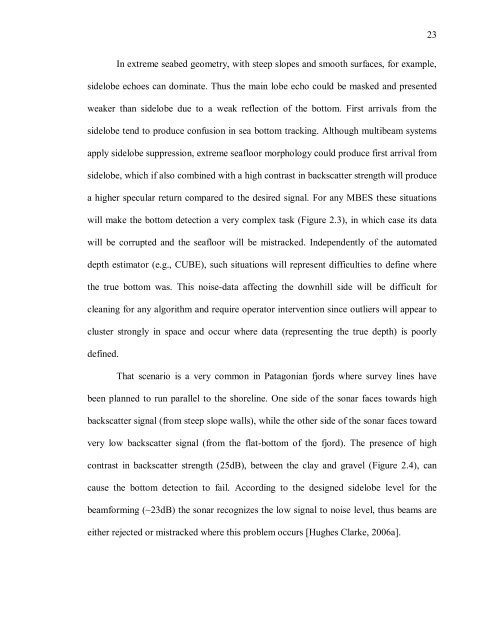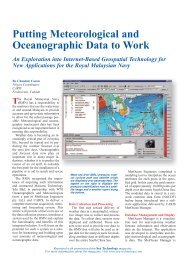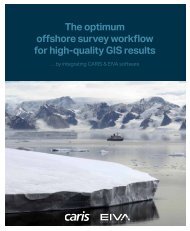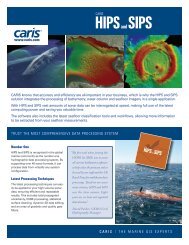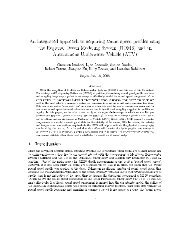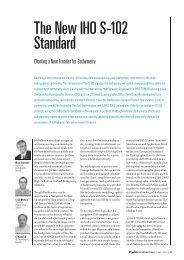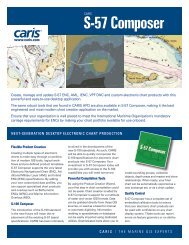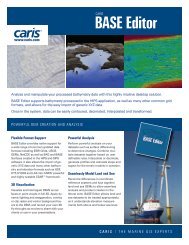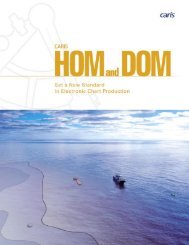Tuning the CARIS implementation of CUBE for Patagonian Waters.pdf
Tuning the CARIS implementation of CUBE for Patagonian Waters.pdf
Tuning the CARIS implementation of CUBE for Patagonian Waters.pdf
You also want an ePaper? Increase the reach of your titles
YUMPU automatically turns print PDFs into web optimized ePapers that Google loves.
In extreme seabed geometry, with steep slopes and smooth surfaces, <strong>for</strong> example,<br />
sidelobe echoes can dominate. Thus <strong>the</strong> main lobe echo could be masked and presented<br />
weaker than sidelobe due to a weak reflection <strong>of</strong> <strong>the</strong> bottom. First arrivals from <strong>the</strong><br />
sidelobe tend to produce confusion in sea bottom tracking. Although multibeam systems<br />
apply sidelobe suppression, extreme seafloor morphology could produce first arrival from<br />
sidelobe, which if also combined with a high contrast in backscatter strength will produce<br />
a higher specular return compared to <strong>the</strong> desired signal. For any MBES <strong>the</strong>se situations<br />
will make <strong>the</strong> bottom detection a very complex task (Figure 2.3), in which case its data<br />
will be corrupted and <strong>the</strong> seafloor will be mistracked. Independently <strong>of</strong> <strong>the</strong> automated<br />
depth estimator (e.g., <strong>CUBE</strong>), such situations will represent difficulties to define where<br />
<strong>the</strong> true bottom was. This noise-data affecting <strong>the</strong> downhill side will be difficult <strong>for</strong><br />
cleaning <strong>for</strong> any algorithm and require operator intervention since outliers will appear to<br />
cluster strongly in space and occur where data (representing <strong>the</strong> true depth) is poorly<br />
defined.<br />
That scenario is a very common in <strong>Patagonian</strong> fjords where survey lines have<br />
been planned to run parallel to <strong>the</strong> shoreline. One side <strong>of</strong> <strong>the</strong> sonar faces towards high<br />
backscatter signal (from steep slope walls), while <strong>the</strong> o<strong>the</strong>r side <strong>of</strong> <strong>the</strong> sonar faces toward<br />
very low backscatter signal (from <strong>the</strong> flat-bottom <strong>of</strong> <strong>the</strong> fjord). The presence <strong>of</strong> high<br />
contrast in backscatter strength (25dB), between <strong>the</strong> clay and gravel (Figure 2.4), can<br />
cause <strong>the</strong> bottom detection to fail. According to <strong>the</strong> designed sidelobe level <strong>for</strong> <strong>the</strong><br />
beam<strong>for</strong>ming (~23dB) <strong>the</strong> sonar recognizes <strong>the</strong> low signal to noise level, thus beams are<br />
ei<strong>the</strong>r rejected or mistracked where this problem occurs [Hughes Clarke, 2006a].<br />
23


